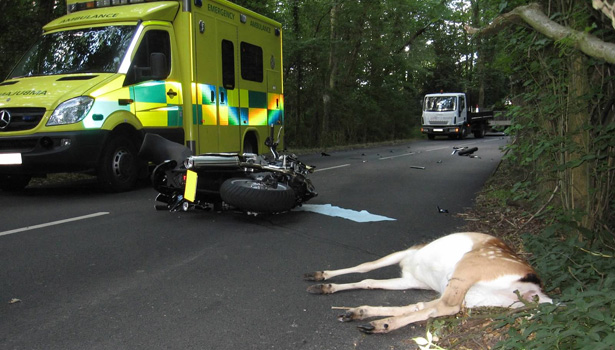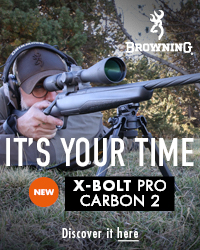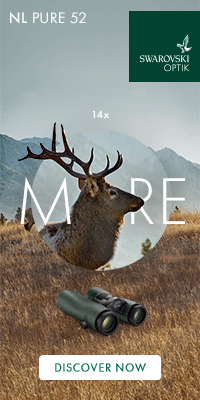Stuart Morrison from East Sussex Deer Management provides an insight into the Deer Warden scheme operating in Sussex.
Three years ago I joined the East Sussex Deer Warden Scheme. This project was set up jointly by Sussex Police and East Sussex County Council as a result of the high levels of Deer and Vehicle Collisions (DVC's) in the county, particularly around Ashdown Forest in the North of the county.

Around half of the deer hit by vehicles are still alive and needed to be put down as quickly and safely as possible. So the deer warden scheme was born and a number of volunteer stalkers were trained and issued with personal protective equipment and road signs enabling them to deal safely and effectively with injured deer on or near the roadway. Sussex Police maintain a call out list of the Deer Wardens who are mostly on call 24 hours a day. There is no payment of any kind to the Wardens. They all give up their time for free.
A call out is initiated from Sussex Police control room and you receive a phone call asking if you can attend. If not, the call goes out to the next on the list in your area. If you are able to attend you are issued with an incident number (without this you are not authorised to use your firearm or covered by the Police Insurance policy). You are also given the address and details of the call and sometimes the phone number of the original caller. This has proved useful on numerous occasions when trying to locate a deer by the roadside in the dark.
The primary concern when attending any call is safety for yourself any other bystanders and the road users themselves.The majority of calls seem to happen after dark with a definite peak around Fallow rut time. All wardens are issued with reflective clothing and an orange flashing light for their vehicle.
Since joining the scheme I have attended about sixty DVC calls. Some turn out to be wild goose chases and sometimes when the call comes in, you are given the details and you can tell this might be the case. Details can be vague such as 'the deer was seen lying in the ditch about an hour ago when the caller walked past'. The location details can be very bad. I've had locations given which were as much as five miles away from the actual incident.
You never really know quite what to expect when you turn up. It can be simply a quiet injured doe lying on the verge of a country lane, to a large Fallow Buck which is staggering around in the middle of a major 'A road' after dark during the rush hour!
Often there are regular calls to the same location where deer cross roads. Indeed I have attended one particular spot only a mile or so away from my home on four separate occasions. One of these was a very serious collision involving two deer and two cars. There were people trapped in both cars. Another involved a bus, two cars and a Fallow fawn, with people injured on the bus.
Bystanders with the best of intentions can be a particular problem. As a Deer Warden your objective is to safely and quickly assess the situation and dispatch the injured animal with minimal fuss. I have, all too often had to explain to people who are literally cradling injured deer that the best thing for the animal is euthanasia. It can be a thankless task as you are accused of being cruel and thoughtless.
Things can go the other way with people trying to dispatch the deer themselves. One evening I was called out to an injured Fallow Pricket about ten miles from home. Sickeningly, when I arrived a man who was standing on the deer's windpipe explained to me that he had tried several times to break the deer's neck but didn't know if he had the right technique. I dispatched the deer quickly and had a few words with him!!
A regular comment when you arrive on scene is that 'the deer only has a broken leg' I always explain to those present that the deer is very likely to have far more serious injuries. In fact my own Post Mortems usually reveal that a deer unable to stand has a fractured pelvis. I have actually seen a deer with two legs broken on the same side run off from a Deer Vehicle Collision several hundred yards! We all know that a single damaged leg can be no great hardship to deer in the wild.
I usually take a rifle and shotgun with me for a call received at home. If I'm already out shooting then it's whatever I have. My weapon of choice is the .22 rifle with subsonic ammunition. This is legal to use on deer BUT only for dispatching a wounded animal. At close range with a headshot this is adequate to kill instantly. There is no need to further upset bystanders with a massive bang from a larger firearm, and often they don't even know the deer has been put down. A good backstop is essential and this isn't always available so the shotgun goes with me as a slightly safer option.
Once the incident is over a form has to be filled out and sent off to the Police for their records and this in turn is sent for Deer Vehicle Collision statistics.
I think it's great that Deer Stalkers perform this role which helps with our relationship with both Police and the general public. The alternative is that deer suffer a slow painful death lying in the road or verge.
To find out more about the growing problem of DVC's visit The National Deer-Vehicle Collisions Project at http://www.deercollisions.co.uk/index.html
Stuart Morrison is an experienced Deer Manager working in the East Sussex area, for more information or to contact him visit his website for more details: http://www.eastsussexdeermanagement.org


















